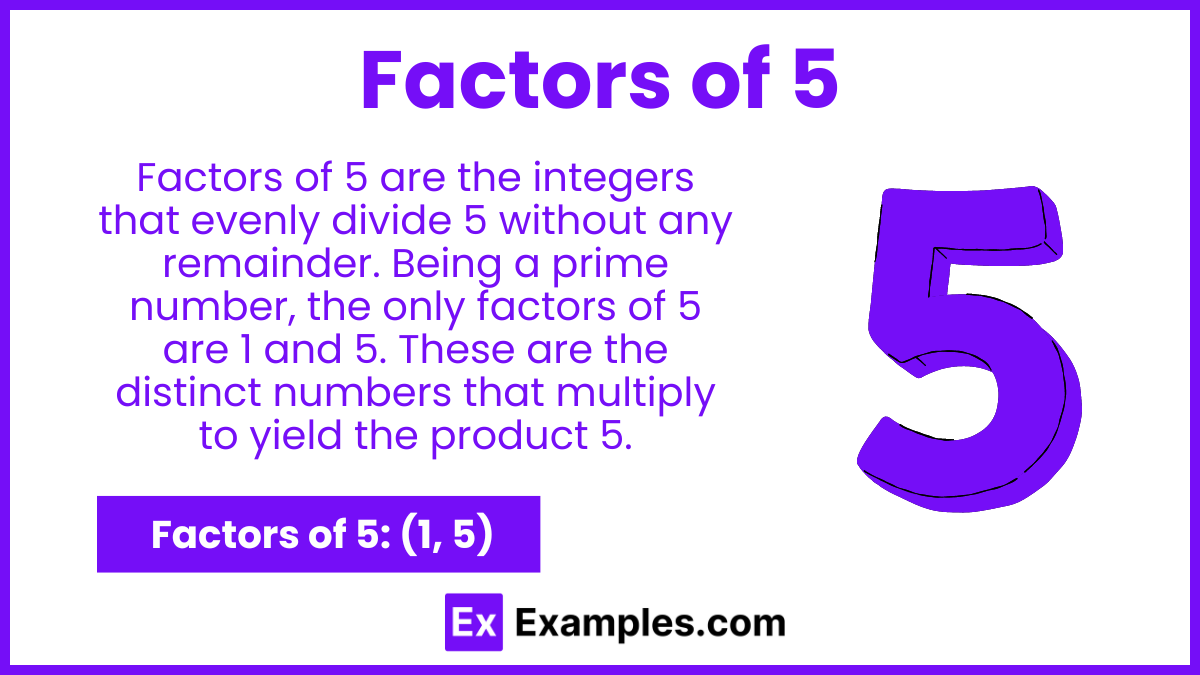Which of the following numbers is a factor of 5?
2
3
5
10

Factors of 5 are the numbers that can be multiplied together to produce the original number, 5. These factors are 1 and 5. When you divide 5 by any of these numbers, the result is a whole number with no remainder. Understanding the factors of a number is essential in various mathematical calculations, including simplifying fractions, finding common denominators, and solving algebraic equations. The simplicity of 5, being a prime number, means its factors are limited, making it a straightforward example for learning about the concept of factors in mathematics.

The factors of 5 are the numbers that can be multiplied together to result in 5. These numbers are 1 and 5. When 5 is divided by either of these factors, the result is a whole number with no remainder. This makes 5 a prime number, as it has exactly two distinct factors: 1 and itself. Understanding factors is crucial for various mathematical operations, including simplifying fractions and solving equations. The factors of 5 are straightforward due to its prime nature, illustrating the concept of factors clearly and simply.
Factor pairs of 5 are the sets of two numbers that, when multiplied together, equal 5. Since 5 is a prime number, it has only one factor pair:
This means 1 multiplied by 5 equals 5. Factor pairs are useful in various mathematical contexts, such as solving equations and understanding number properties. For the number 5, its single factor pair (1, 5) reflects its simplicity as a prime number.
Calculating the prime factors of a number involves breaking it down into the prime numbers that multiply together to give the original number. For the number 5, here’s a step-by-step guide:
Prime numbers are natural numbers greater than 1 that have no divisors other than 1 and themselves. Examples include 2, 3, 5, 7, and so on.
Recognize the number you want to factorize. In this case, it is 5.
Start with the smallest prime number, which is 2. Determine if 2 can divide 5 without leaving a remainder. Since 5 is an odd number, 2 cannot divide it.
Proceed to the next prime number, which is 3. Check if 3 can divide 5. Since 5 divided by 3 leaves a remainder, 3 is not a factor of 5.
Since no smaller prime numbers can divide 5, check if 5 is a prime number. A prime number is only divisible by 1 and itself. Since 5 meets this criterion, it is a prime number.
Conclude that the prime factors of 5 are simply the number 5 itself.
You need to divide a set of 5 pencils equally among 5 students.
Each student receives 5/5=1 pencil.
A smoothie recipe calls for 5 bananas to serve 5 people. You need to adjust the recipe to serve 10 people.
Double the number of bananas using the factor 5. So, 5×2=10 bananas are needed for 10 people.
You have 25 stickers and want to distribute them equally in 5 gift bags.
Divide the stickers by the number 5. Each bag gets 25÷5=5 stickers.
25 students need to be divided into teams, each containing 5 students.
Form teams by dividing the total number of students by 5. There are 25÷5=5 teams.
You want to calculate the first five multiples of 5 to help students learn multiplication.
Understanding the factors of a number can simplify many mathematical tasks, from simplifying fractions to solving complex equations. The number 5, being a prime number, has unique characteristics that make it straightforward yet essential in various calculations. Here are some tips and tricks to help you master the factors of 5.
Yes, when discussing factors in the context of integers, the factors of 5 are always whole numbers. They include both positive (1, 5) and negative (-1, -5) whole numbers.
Yes, 5 can be a factor of composite numbers. A composite number is a number that has more than two factors. For example, 10 and 15 are composite numbers that have 5 as one of their factors.
Yes, 5 can be considered a factor of zero because any non-zero number multiplied by zero equals zero. Hence, 5 multiplied by zero equals zero.
Yes, prime factorization can be applied to 5. Since 5 is already a prime number, its prime factorization is simply 5 itself.
Yes, 5 is a common factor of both 20 and 25. This is because 5 divides both numbers exactly: 20÷5=420÷5=4 and 25÷5=525÷5=5.
No, 5 is not divisible by any number other than 1 and itself. As a prime number, its only divisors are 1 and 5.
A factor tree of 5 is simple since 5 is a prime number. The factor tree consists of 5 itself, with no further branches as it cannot be factored further.
A factor tree of 5 is simple since 5 is a prime number. The factor tree consists of 5 itself, with no further branches as it cannot be factored further.
Text prompt
Add Tone
10 Examples of Public speaking
20 Examples of Gas lighting
Which of the following numbers is a factor of 5?
2
3
5
10
Which number is not a factor of 5?
1
5
8
25
Which of these numbers is a multiple of a factor of 5?
30
31
32
33
What is the smallest factor of 5?
1
2
5
10
Which number is a factor of 5 and is also an odd number?
4
5
6
10
How many factors does the number 5 have?
2
3
4
5
Which of the following is not a factor of 5?
1
3
5
10
If you multiply a factor of 5 by 5, which result is a multiple of 5?
3
7
10
12
Which of these numbers is a factor of 5 and is a prime number?
2
4
5
6
Which number less than 10 is a factor of 5?
2
3
4
5
Before you leave, take our quick quiz to enhance your learning!

